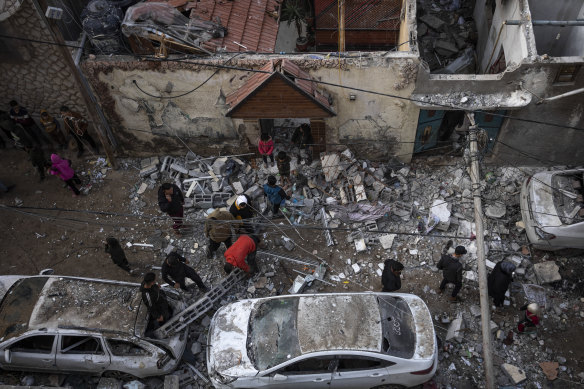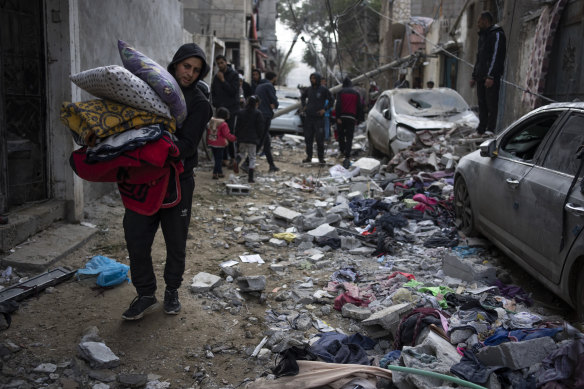This was published 1 year ago
Its population swelled from 200,000 to 1.5 million in three months. Now Israeli forces are coming
By Najib Jobain and Lee Keath
Rafah, Gaza Strip: Gaza’s southernmost town, Rafah, is bursting at the seams. Nearly the last place spared an Israeli offensive so far, Rafah’s population has more than quintupled, with Palestinians streaming in to escape fighting. They pack by the dozens into apartments. Pavements and once-empty lots are clogged with tents full of families.
Panic and despair are rising after Israel said it intends to attack Rafah next. The estimated 1.5 million people sheltering there – more than half of Gaza’s population - have nowhere to flee in the face of an offensive that has levelled large swaths of the urban landscape in the rest of the territory.
Some are just sick of running.
“We’re exhausted. Seriously, we’re exhausted. Israel can do whatever it wants. I’m sitting in my tent. I’ll die in my tent,” said Jihan al-Hawajri, who has fled multiple times from the far north down the length of the Gaza Strip and now lives with 30 relatives in a tent.
UN officials warn that an attack on Rafah will be catastrophic, with more than 600,000 children in the path of an assault. A move on the town and surrounding area also could cause the collapse of the humanitarian aid system struggling to keep Gaza’s population alive.
Israel says it must take Rafah to ensure Hamas’ destruction. On Friday (local time), Prime Minister Benjamin Netanyahu ordered the military to come up with an evacuation plan after the US said it opposed an attack on Rafah unless provisions were made for its population.
“It is impossible to achieve the goal of the war without eliminating Hamas, and by leaving four Hamas battalions in Rafah. On the contrary, it is clear that intense activity in Rafah requires that civilians evacuate the areas of combat,” Netanyahu’s office said in a statement.
“Therefore, Prime Minister Benjamin Netanyahu has ordered the IDF (Israel Defence Forces) and the security establishment to submit to the cabinet a combined plan for evacuating the population and destroying the battalions.”
The statement, issued two days after Netanyahu rejected a Hamas ceasefire proposal that also envisaged the release of hostages held by the Palestinian militant group, gave no further details.
To “conduct such an operation right now with no planning and little thought in an area where there is sheltering of a million people would be a disaster,” US State Department spokesman Vedant Patel said. “This is not something that we’d support.”
Still, Washington has continued its wholehearted military and diplomatic support for Israel’s campaign, despite Israel shrugging off its previous calls to reduce civilian casualties.
In response to those calls, Israel widened its evacuation orders as its forces moved south – yet the death toll in Gaza has continued to mount. Israel says Hamas is responsible for concentrating its forces in civilian areas.
But it’s unclear where civilians would evacuate. Rafah lies trapped between Egypt to the south, the Mediterranean Sea to the west, Israel to its east and Israeli troops to its north. Earlier in the war, Israel declared that a sliver of rural area on the coast neighbouring Rafah, known as Muwasi, to be a safe zone. But in recent weeks it has bombarded the area and sent troops to seize parts of it.

Palestinians looking at the destruction after an Israeli airstrike in Rafah, Gaza Strip.Credit: AP
Many Palestinians in Rafah came from Gaza City and other parts of the north and want to return there. But so far, Israel has shown no willingness to allow a mass movement back north, where it says its troops largely have operational control but still fight pockets of Hamas fighters.
Egypt has staunchly refused any mass exodus of Palestinians onto its soil, fearing Israel will not allow them to return. Israel is not likely to let hundreds of thousands of Palestinians take shelter on its own territory.
A large area of empty dunes between the town of Rafah and the sea is now built up with a dense tent city erected by those streaming in over the past month.
When winter rains hit, the area turns to cold mud, seeping into tents full of extended families with children. Women hang up bedding on clothes lines in the morning to keep them dry during the day, then lay them on the ground at night to sleep.
In Rafah town itself, the main squares and streets are full of tents. Other families fill classrooms at UN schools or crowd with relatives in apartments. Everyone is hungry and sick; colds, coughs and intestinal disorders run rampant. Even simple medicines are difficult to find, requiring an hours long wait at the pharmacy.
The supply chain for everything from canned food and flour to diapers comes almost entirely from the trickle of aid trucks that Israel allows into Gaza for distribution by the UN and other humanitarian groups. Large impromptu outdoor markets packed with people fill main avenues as many sell parts of allotments they receive.
With such a limited supply, prices have skyrocketed. A chocolate bar that once went for the equivalent of 50 US cents now costs $US5; a single egg can cost nearly $US1.
Groups of young men can sometimes be seen hanging around intersections, waiting for aid trucks to pass. They leap on the back and slash the ropes with knives to pull off bags of flour – to sell or give to their families.

Pressure is mounting on Israel over its threat to launch a ground assault on Rafah, the last refuge for hundreds of thousands of Palestinians.Credit: AP
UN officials say 90 per cent of Gaza’s population is eating less than one meal a day, and a quarter of the population faces outright famine, mainly in the north, where Israeli restrictions have blocked many aid convoys.
Rafah is the heart of the aid campaign, with trucks entering from Egypt or from a nearby Israeli crossing for distribution across the Gaza Strip.
“Any large-scale military operation among this population can only lead to additional layers of endless tragedy,” Philippe Lazzarini, head of UNRWA, the main agency leading the humanitarian effort said.
Israel has vowed to eliminate Hamas throughout the Gaza Strip after the group’s October 7 attack on southern Israel, in which some 1200 people were killed and the militants abducted some 250 hostages – over 100 of whom remain in captivity. Netanyahu said this week that preparations were underway for the military to move on Rafah, though he did not say when.
“We are on the way to an absolute victory,” he said. “There is no other solution.”
The Israeli onslaught has killed nearly 28,000 Palestinians and left much of northern Gaza a devastated wasteland. For weeks, fighting has focused on central Gaza and the southern city of Khan Younis, where bombardment and ground fighting has wreaked similar destruction.
In recent days, Israeli bombardment of Rafah has escalated. On Friday, strikes levelled two buildings, killing at least eight, including three children and a woman.
In the tent city, Najah Hasheasho said the wooden frame draped with plastic that her family lives in shakes every time a blast hits the area.
“We want to go back to Gaza City. That’s our home,” she said.
A neighbour in the camp, Nahed Abu Asi, said that like many, he believes Israel wants to push the population into Egypt permanently.
“We won’t go into Egypt,” he said. “We’ll make our way back to Gaza City and die there – or in any place on the soil of Gaza.”
AP, Reuters
Get a note directly from our foreign correspondents on what’s making headlines around the world. Sign up for the weekly What in the World newsletter here.